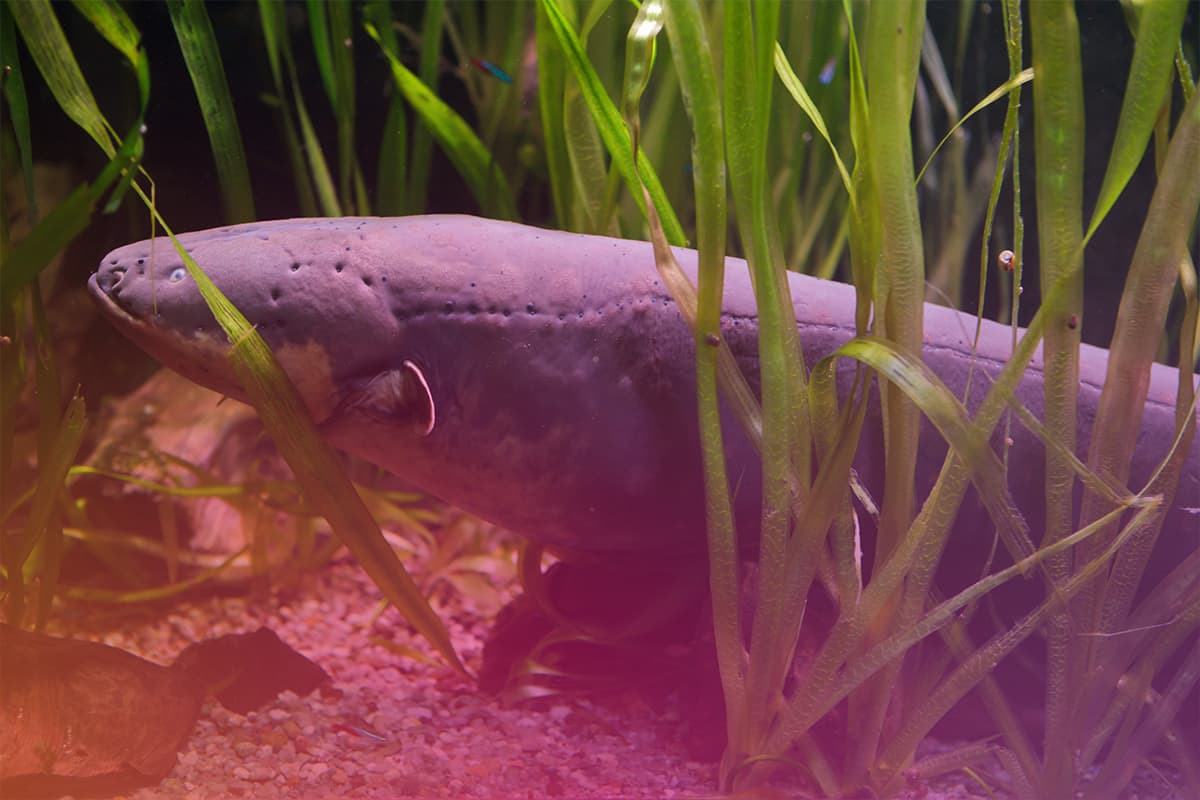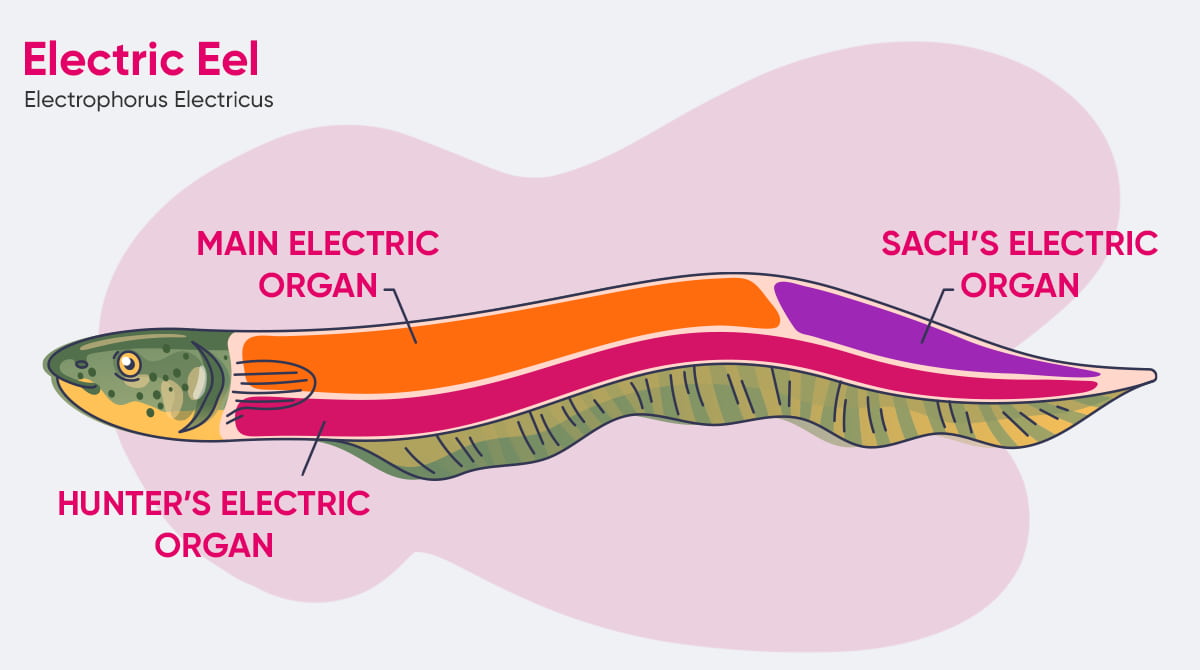
What is in this article?
Many advancements in the study of electricity and magnetism were accomplished during the so-called electric age of the 18th and 19th centuries. One of these findings concerned electric eels.
During his research on animals, Luigi Galvani made the discovery of animal electricity. As a result, he started studying electric eels. Even underwater, these fish are able to produce a significant amount of electricity. Alessandro Volta created the first type of contemporary battery at the same time that Michael Faraday outlined the relationship between electricity and magnetism. One of the research efforts at the time that led to other discoveries in the fields of electricity and magnetism was the discovery of the electric eel.
Find out how many volts the electric eel generates, different types of the species, and what else it can do in this article.
How Electric Eels Immediately Produce Huge Electrical Voltage
In addition to their defense mechanism and hunting ability, eels have a special ability to generate electricity. This ability is made possible by unique organs known as electrocytes. Cells made of potassium and sodium ions are known as electrocytes. The potassium ions are transferred outside as a result of the change in concentration. This means that the inside of the cell is negatively charged and the outside of the cell is positively charged. Electrocytes stimulated by signals from the brain open the cell membranes and allow sodium ions to enter the cell. This causes an electrical charge exchange within the cell resulting in an electrical current. An electric current of about 600 volts is produced when thousands of electrocyte cells function concurrently. The eels benefit significantly from this trait in their struggle for existence.
The electric organ, a unique organ in the electric eel, is where electricity is produced. This organ, which is a lengthy structure that extends along the lower part of the eel's body, is made up of thousands of electrophile cells. Electrophiles are specialized cells, each of which can accumulate negatively charged ions (atoms that carry an electric charge). Electricity is generated through a series of processes controlled by the electrophiles in the nervous system of the electric organ. The eel tenses its muscles to activate each electrophile one at a time. Positively charged sodium ions are quickly taken up by active cells, which then quickly pick up additional negative charges. Due to the electrical potential difference between within and outside the cell, electrophiles get electrically charged.

Electrophiles are configured differently in the electrical organ. Electrophiles that accumulate ions are concentrated around the electrical organ's head. The low-charge zone, in contrast, is formed by electrophiles near the end of the electrical organ. This structure creates a voltage difference between the two sides of the electrical organ.
The eel has an electrical circuit-like body structure in addition to an electric organ that generates a voltage difference. In the electric organ, positively charged electrophiles interact with negatively charged electrophiles. The eel's body can conduct electricity thanks to these connections.
The nervous system of the eel transmits electrical signals to the electrical organ when it detects prey or a potentially dangerous target. Rapid activation and negative charge accumulation occur in the electrophiles. The electrical potential difference between the cells is increased as a result of this action, which causes the electrical current to build quickly and provide a high-voltage shock.
How Is It That the Electricity Does Not Harm the Fish?
Separated from the rest of the fish's body are the unique cells in eels' bodies that produce electricity. These cells are isolated in order to protect surrounding tissues. The electrical organs, on the other hand, function with less resistance than other body parts. As a result, other tissues are not harmed by the current because it exclusively runs between specific organs.
The fact that eels have unique sensory organs to detect electrical impulses is another reason why the electricity generated does not harm the eel itself. These special sensory organs are stimulated enough to protect themselves from the electrical signals they produce. All of these characteristics prevent the created electric from harming the eel itself.
Types of Electric Eel
Electric eels belong to fish families that can live in freshwater environments all over the world. The most common species and their characteristics can be summarized as follows:
- Electrophorus Electricus: This species of electric eel, which lives in South American rivers, can reach an average length of 2 to 2.5 meters and weighs 20-25 kg. It is very effective at generating electricity. So much so that it can generate a high voltage of up to 600 volts with a single shock. The fish's body contains special cells called electroplax that enable it to recognize low-frequency electric fields.
- Campylomormyrus Tamandua: This species, known as the African electric eel, lives in the freshwater rivers of Africa. It is a current-producing fish that is smaller than other species. It can reach an average length of 15-20 cm and weighs 50-60 grams. The voltage of current generation is lower than other fish.
- Gymnotus Carapo: The South American knife eel lives in the freshwater rivers of South America. On average they are 30-40 cm long and weigh 300-400 grams. Even though they produce less current than other species, they may nevertheless produce current up to 200 volts.
Where Do Electric Eels Live?
 Electric eels are generally freshwater fish. They generally prefer to live in tranquil waters such as wetlands, marshes, rivers, and ponds. In terms of water quality, nutrients, and living conditions, they are commonly found in rivers.
Electric eels are generally freshwater fish. They generally prefer to live in tranquil waters such as wetlands, marshes, rivers, and ponds. In terms of water quality, nutrients, and living conditions, they are commonly found in rivers.
These fish are rarely found in areas with rapid water flow. Water temperature in their habitat should be between 23 and 28 degrees.
Large, quiet waters are often the electric eels' habitats. When these water bodies are turbid and poor in oxygen, they can adapt more effectively. This is why they are commonly found in Guyana, northeastern Brazil, Colombia, Ecuador, Peru and Suriname, the Orinoco River basin, the islands of Trinidad and Tobago, and northwestern Venezuela.
Due to the absence of fresh water resources and the cool water temperature, there are no electric eels in Turkey. They can be produced and displayed in aquariums or other specific facilities in a number of countries, with the exception of warm fresh waters above the equator.
Characteristics of the Electric Eel
 Electric eels are carnivores. They usually feed on small fish, frogs, crabs, crustaceans and some insects. They kill and dismember their large prey using electric shocks. When it comes to hunting, they do not swim with their fins like other fish do. They move slowly to observe the things in their surroundings and use electric shocks to capture their prey. The muscles of the prey are paralyzed by the electric shocks they deliver. This makes it simple for the eel to capture its prey.
Electric eels are carnivores. They usually feed on small fish, frogs, crabs, crustaceans and some insects. They kill and dismember their large prey using electric shocks. When it comes to hunting, they do not swim with their fins like other fish do. They move slowly to observe the things in their surroundings and use electric shocks to capture their prey. The muscles of the prey are paralyzed by the electric shocks they deliver. This makes it simple for the eel to capture its prey.
The electric eel is a type of fish that people don't eat. They are not consumed or fished for commercial purposes. According to several research, eating electric eel meat may be bad for one's health. These studies concentrate on the health dangers posed by mercury, arsenic, and other heavy metals that build up in the bodies of electric eels.
For instance, a research study released in 2010 revealed that persons in Brazil who regularly ingested electric eel had higher mercury levels in their bodies. On the other hand, this research also revealed that consuming too much mercury might have detrimental consequences on kidney function, the neurological system, and infant development.
The Amazon Basin's electric eels have mercury levels that are substantially beyond the daily exposure guidelines, according to another study published in 2019. This study also found that actions like restricting or banning the consumption of electric eels should be taken.
When people first learn about electric eels, one of the questions they have is whether or not they can be held. Electric eels can be held in normal circumstances, but researchers on these fish species utilize specialized equipment in case they deliver electric shocks. In addition to electric shocks, several species also have mouthparts and teeth that are extremely sharp. To prevent injuries, proper protective gear is worn.
Eels are typically delicate and quickly stressed. As a result, they need to be handled delicately and cautiously. Many different eel species do not enjoy being touched and may defend themselves by biting or shocking you with electricity. The electric eel is the only animal that can produce electricity while breathing, which is an intriguing fact that isn't typically mentioned. Other electricity-generating animals can only use the electrical energy they produce before they breathe.
The genes of the electric eel could aid research into how electric cells function. Future development of novel electrical generators or therapeutic cells might be possible with the use of this information. However, the organs that produce electricity are even bigger than the fish's brain and account for around 20% of its entire weight. The temperature of the water affects the electric eels' capacity to produce electricity and deliver the subsequent shock. Warm water helps fish produce higher voltages while cold water decreases their ability to do so.
Are There Other Creatures That Can Generate Electricity?
Besides the electric eel, there are other creatures in nature that can generate electricity. These species and their characteristics can be summarized as follows:
- Electric Swordfish (Narcine Bancroftii): The electric swordfish, which normally lives in the Caribbean Sea and some parts of the Atlantic Ocean, has equipped itself with special organs to generate electricity.
- Torpedo Fish (Torpedo Marmorata): This species, which lives in the Mediterranean Sea, averages 1 meter in length and 25 kg in weight. They have a very effective body structure in terms of electricity generation and can produce up to 200 volts of electricity.
- Seahorse (Hippocampus Spp.): Some seahorse species, especially in the western Pacific, can also generate electricity, though very little, and is usually used for communication purposes.
- Electric crab (Electrophorus spinicauda): This species of crab, which lives in the seas off the Pacific coast, is 60 cm long and weighs 3 kg on average. It is very effective at generating electricity and can provide a voltage of up to 200 volts.
- Oriental hornet (Vespa orientalis): It has been discovered that the cuticle (exoskeleton) of the oriental hornet has a yellow stripe that can absorb sunlight, capturing some of the sun's radiation and generating a small electrical potential, while the brown tissue generates electricity.

In summary, electric eels are unique electricity generators in the animal kingdom. The ability to generate electricity thanks to the electrical organs in its body has attracted the attention of researchers in medicine, robotics, and many other fields. The power generation process of the electric eel is highly sophisticated and unique. These qualities keep it in the scientific community's attention, and research into it is ongoing.
The power generating system of the electric eel and our understanding of its characteristics are on the verge of inspiring researchers to create artificial electrogenic organs. Artificial electrogenic organs allow persons with limitations to move more freely by generating electric fields that can be controlled by brain signals. In light of this, scientific studies on the generation and management of electricity continue to focus on the electric eel.
The electric eel is also used as a model organism for research in medicine and neuroscience. The electric organs of the eel have also inspired the development of electrodes for signal amplification systems used in neurological research.
What interests you most about creatures that generate electricity? Please share your comments with us.

 Online Services
Online Services Application Inquiry
Application Inquiry Pay Assurance Fee
Pay Assurance Fee Query Installation Number
Query Installation Number Compensation Fee Inquiry
Compensation Fee Inquiry Automatic Payment Order Inquiry
Automatic Payment Order Inquiry Partnership
Partnership







Leave a Comment